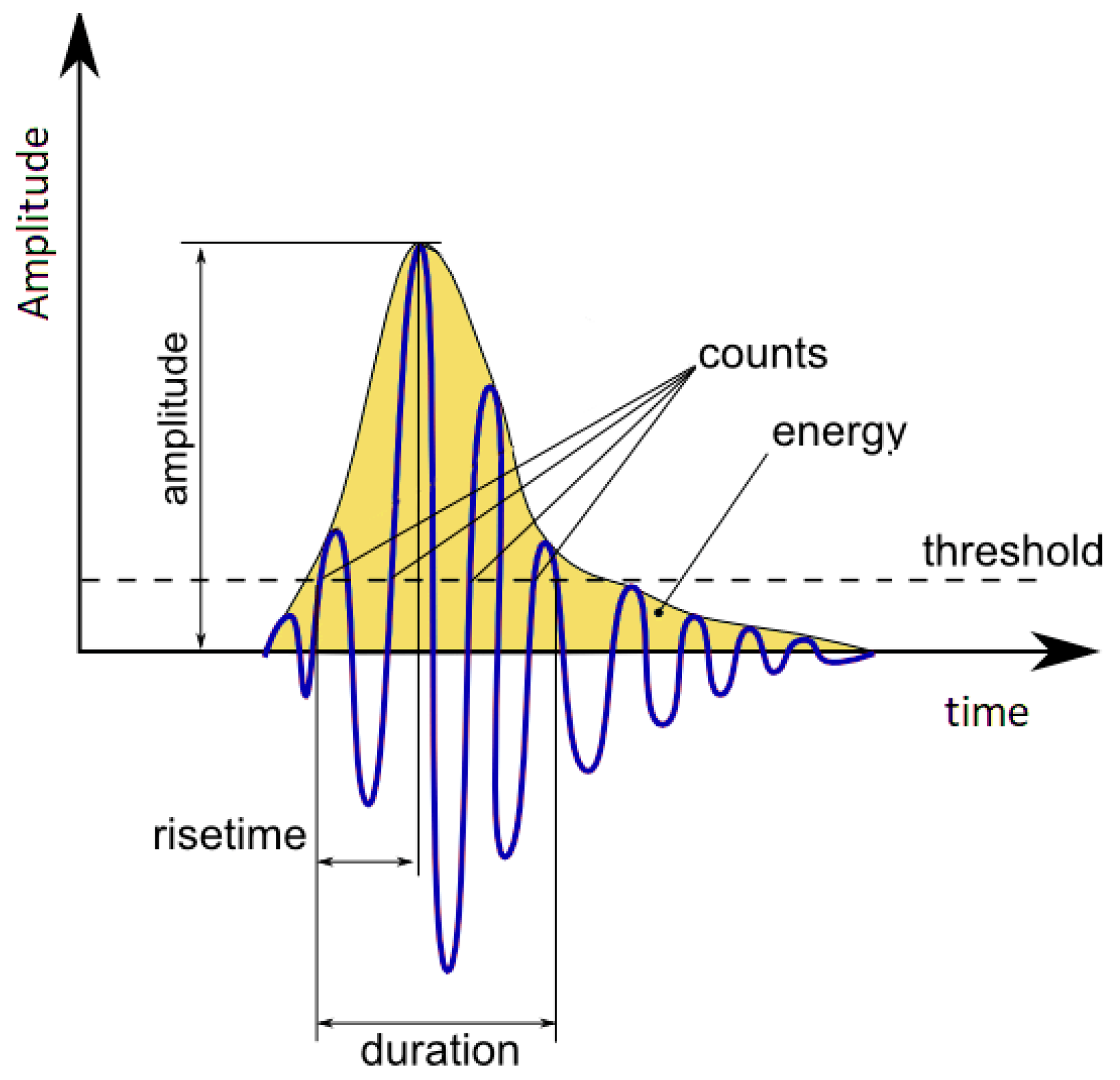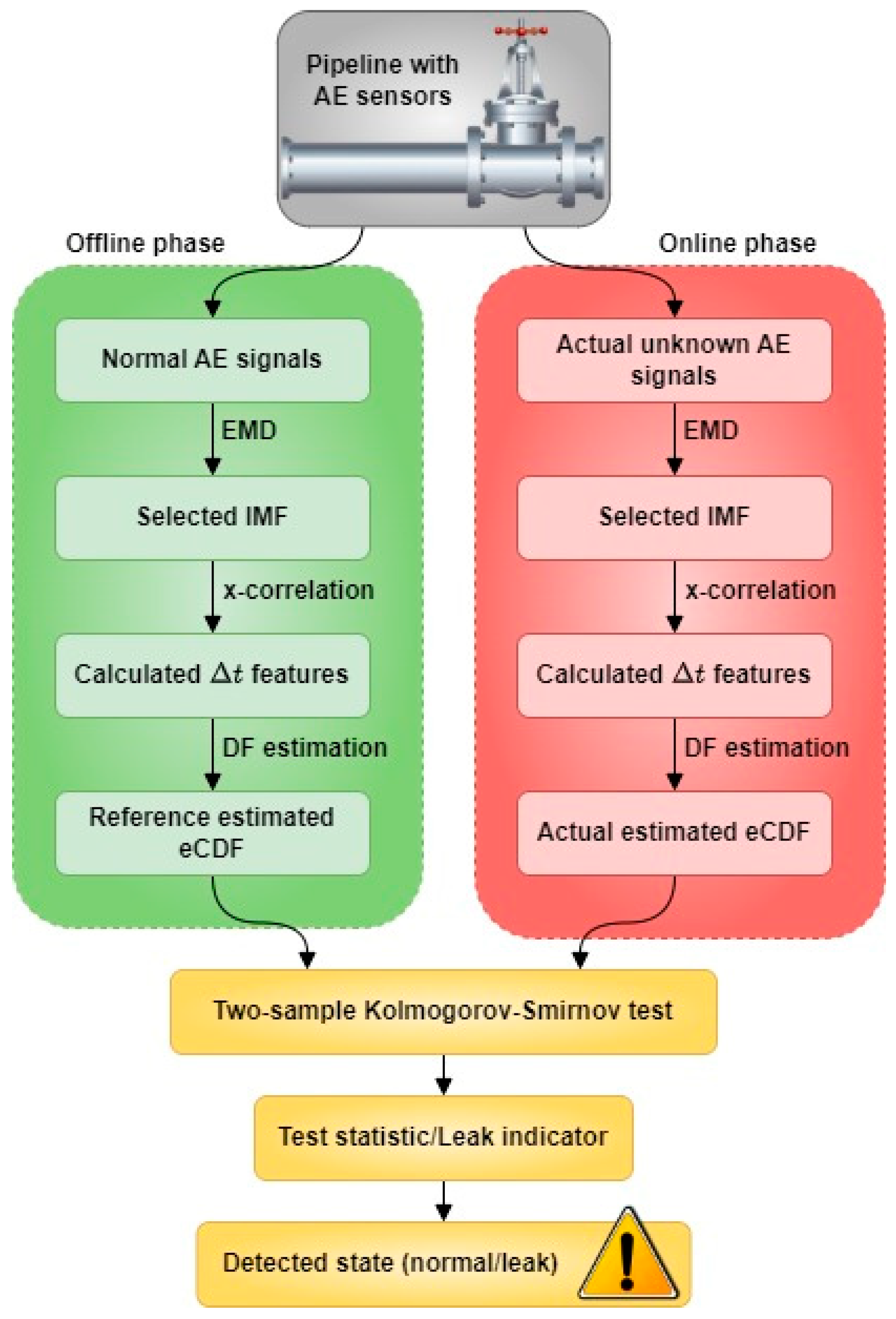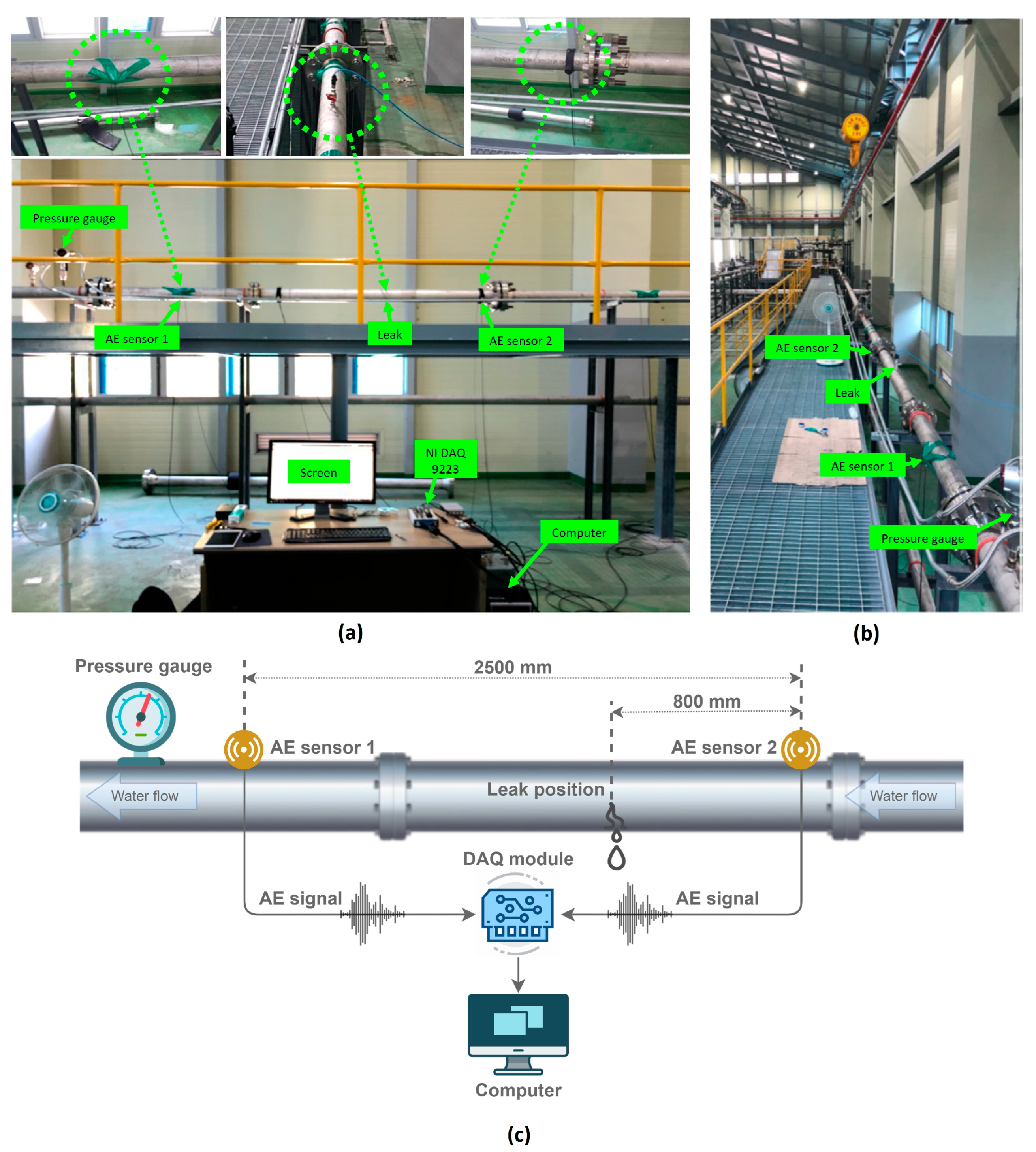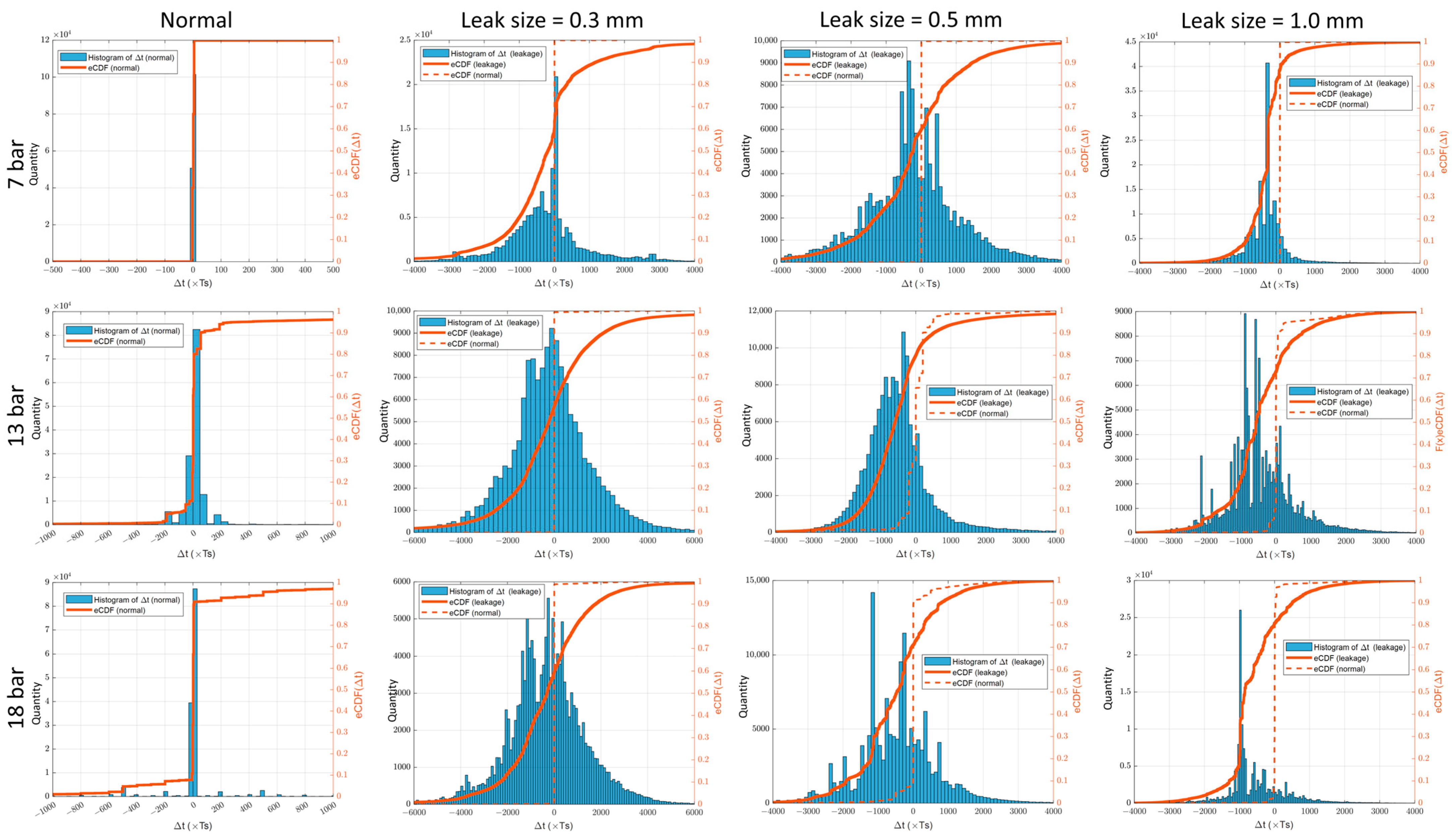A Reliable Pipeline Leak Detection Method Using Acoustic Emission with Time Difference of Arrival and Kolmogorov–Smirnov Test
Abstract
:1. Introduction
- We proposed a novel and reliable indicator for pipeline leak state detection based on AE signals using the time difference of arrival feature and the two-sample K–S test.
- Verification and evaluation experiments were conducted using a custom industrial pipeline system for effectiveness and robustness of the proposed method.
2. Background Concepts
2.1. Empirical Mode Decomposition (EMD)
2.2. Time Difference of Arrival
2.3. Two-Sample Kolmogorov–Smirnov Test
3. Proposed Method
- Step 1: AE signals from the two AE sensors are collected from the pipeline.
- Step 2: EMD decomposition is implemented to decompose the raw AE signals into intrinsic mode functions (IMFs). Figure 3 illustrates the time-domain signal and the power spectrum of a raw AE signal along with its IMFs. Since low-order IMFs contain high-frequency components, they effectively represent the AE signals [39]. Experimental results show that the first-order IMF usually contains high-frequency noise (over 150 kHz) and should be disregarded [40]. Thus, in this step, the second-order IMF is selected for further processing, as it contains useful and less noisy AE signals.
- Step 3: TDOA (Δt) of the two AE signals is calculated using the cross-correlation (x-correlation) technique. To avoid randomness, Δt should be calculated on various scales of signal length and should be selected from several lag times with the highest correlation instead of only one. Hence, the AE signals are divided into multiple segments with three different lengths based on the estimated length of AE events. Then, three lag times corresponding to the highest correlations are selected to represent the Δt.
- Step 4: The eCDFs of the Δt values obtained in step 3 are estimated (DF estimation). For normal AE signals in the offline phase, the resulting eCDFs are referred to as reference estimated eCDF. For actual AE signals (with unknown states) in the online phase, the resulting eCDFs are considered actual estimated eCDFs.
- Step 5: A two-sample K–S test is conducted to examine the similarity between actual and reference estimated eCDFs. The statistical value obtained from the test is considered as an indication of the pipeline leakage state. A higher index suggests a higher probability of pipeline leakage.
4. Case Study
4.1. Experimental Setup
4.2. Results and Discussion
5. Conclusions
Author Contributions
Funding
Institutional Review Board Statement
Informed Consent Statement
Data Availability Statement
Conflicts of Interest
References
- Diao, X.; Chi, Z.; Jiang, J.; Mebarki, A.; Ni, L.; Wang, Z.; Hao, Y. Leak Detection and Location of Flanged Pipes: An Integrated Approach of Principle Component Analysis and Guided Wave Mode. Saf. Sci. 2020, 129, 104809. [Google Scholar] [CrossRef]
- Ahmad, Z.; Nguyen, T.K.; Kim, J.M. Leak Detection and Size Identification in Fluid Pipelines Using a Novel Vulnerability Index and 1-D Convolutional Neural Network. Eng. Appl. Comput. Fluid Mech. 2023, 17, 2165159. [Google Scholar] [CrossRef]
- Zhang, B.; Kang, R.; Zhu, H.; Yuan, Q.; Zhang, Q.; Zhou, X. Numerical Simulation and Safety Evaluation of Multi-Source Leakage of Buried Product Oil Pipeline. Energy Sources Part A Recovery Util. Environ. Eff. 2022, 44, 6737–6757. [Google Scholar] [CrossRef]
- Zhang, Z.; Zhang, L.; Fu, M.; Ozevin, D.; Yuan, H. Study on Leak Localization for Buried Gas Pipelines Based on an Acoustic Method. Tunn. Undergr. Space Technol. 2022, 120, 104247. [Google Scholar] [CrossRef]
- Ahmad, Z.; Nguyen, T.K.; Rai, A.; Kim, J.M. Industrial Fluid Pipeline Leak Detection and Localization Based on a Multiscale Mann-Whitney Test and Acoustic Emission Event Tracking. Mech. Syst. Signal Process. 2023, 189, 110067. [Google Scholar] [CrossRef]
- Xing, J.; Meng, H.; Meng, X. An Urban Pipeline Accident Model Based on System Engineering and Game Theory. J. Loss Prev. Process. Ind. 2020, 64, 104062. [Google Scholar] [CrossRef]
- Lu, H.; Iseley, T.; Behbahani, S.; Fu, L. Leakage Detection Techniques for Oil and Gas Pipelines: State-of-the-Art. Tunn. Undergr. Space Technol. 2020, 98, 103249. [Google Scholar] [CrossRef]
- Korlapati, N.V.S.; Khan, F.; Noor, Q.; Mirza, S.; Vaddiraju, S. Review and Analysis of Pipeline Leak Detection Methods. J. Pipeline Sci. Eng. 2022, 2, 100074. [Google Scholar] [CrossRef]
- Gao, L.; Dong, L.; Cao, J.; Wang, S.; Liu, W. Acoustic Emission-Based Small Leak Detection of Propulsion System Pipeline of Sounding Rocket. Shock. Vib. 2020, 2020, 8875939. [Google Scholar] [CrossRef]
- Hu, Z.; Tariq, S.; Zayed, T. A Comprehensive Review of Acoustic Based Leak Localization Method in Pressurized Pipelines. Mech. Syst. Signal Process. 2021, 161, 107994. [Google Scholar] [CrossRef]
- Philibert, M.; Yao, K.; Gresil, M.; Soutis, C. Lamb Waves-Based Technologies for Structural Health Monitoring of Composite Structures for Aircraft Applications. Eur. J. Mater. 2022, 2, 436–474. [Google Scholar] [CrossRef]
- Drouillard, T.F. A History of Acoustic Emission. J. Acoust. Emiss. 1996, 14, 1–34. [Google Scholar]
- Miller, R.K.; Hill, E.K.; Moore, P.O. Nondestructive Testing Handbook: Acoustic Emission Testing; The American Society for Nondestructive Testing (ASNT): Columbus, OH, USA, 2005; ISBN 9781571171375. [Google Scholar]
- Wang, B.; Zhong, S.; Lee, T.-L.; Fancey, K.S.; Mi, J. Non-Destructive Testing and Evaluation of Composite Materials/Structures: A State-of-the-Art Review. Adv. Mech. Eng. 2020, 12, 168781402091376. [Google Scholar] [CrossRef]
- Bao, X.; Wang, Z.; Fu, D.; Shi, C.; Iglesias, G.; Cui, H.; Sun, Z. Machine Learning Methods for Damage Detection of Thermoplastic Composite Pipes under Noise Conditions. Ocean. Eng. 2022, 248, 110817. [Google Scholar] [CrossRef]
- Yu, Y.; Safari, A.; Niu, X.; Drinkwater, B.; Horoshenkov, K.V. Acoustic and Ultrasonic Techniques for Defect Detection and Condition Monitoring in Water and Sewerage Pipes: A Review. Appl. Acoust. 2021, 183, 108282. [Google Scholar] [CrossRef]
- Wang, F.; Lin, W.; Liu, Z.; Wu, S.; Qiu, X. Pipeline Leak Detection by Using Time-Domain Statistical Features. IEEE Sens. J. 2017, 17, 6431–6442. [Google Scholar] [CrossRef]
- Wang, W.; Sun, H.; Guo, J.; Lao, L.; Wu, S.; Zhang, J. Experimental Study on Water Pipeline Leak Using In-Pipe Acoustic Signal Analysis and Artificial Neural Network Prediction. Measurement 2021, 186, 110094. [Google Scholar] [CrossRef]
- Xiao, R.; Hu, Q.; Li, J. A Model-Based Health Indicator for Leak Detection in Gas Pipeline Systems. Measurement 2021, 171, 108843. [Google Scholar] [CrossRef]
- Bae, J.-H.; Yeo, D.; Yoon, D.-B.; Oh, S.W.; Kim, G.J.; Kim, N.-S.; Pyo, C.-S. Deep-Learning-Based Pipe Leak Detection Using Image-Based Leak Features. In Proceedings of the 2018 25th IEEE International Conference on Image Processing (ICIP), Athens, Greece, 7–10 October 2018; IEEE: Piscataway, NJ, USA, 2018; pp. 2361–2365. [Google Scholar]
- Zhou, M.; Yang, Y.; Xu, Y.; Hu, Y.; Cai, Y.; Lin, J.; Pan, H. A Pipeline Leak Detection and Localization Approach Based on Ensemble TL1DCNN. IEEE Access 2021, 9, 47565–47578. [Google Scholar] [CrossRef]
- Ahmad, S.; Ahmad, Z.; Kim, C.-H.; Kim, J.-M. A Method for Pipeline Leak Detection Based on Acoustic Imaging and Deep Learning. Sensors 2022, 22, 1562. [Google Scholar] [CrossRef]
- Liu, P.; Xu, C.; Xie, J.; Fu, M.; Chen, Y.; Liu, Z.; Zhang, Z. A CNN-Based Transfer Learning Method for Leakage Detection of Pipeline under Multiple Working Conditions with AE Signals. Process Saf. Environ. Prot. 2023, 170, 1161–1172. [Google Scholar] [CrossRef]
- Keleko, A.T.; Kamsu-Foguem, B.; Ngouna, R.H.; Tongne, A. Health Condition Monitoring of a Complex Hydraulic System Using Deep Neural Network and DeepSHAP Explainable XAI. Adv. Eng. Softw. 2023, 175, 103339. [Google Scholar] [CrossRef]
- Glentis, G.O.; Angelopoulos, K. Leakage Detection Using Leak Noise Correlation Techniques. In Proceedings of the Proceedings of the 23rd Pan-Hellenic Conference on Informatics, Nicosia, Cyprus, 28–30 November 2019; ACM: New York, NY, USA, 2019; pp. 50–57. [Google Scholar]
- Tijani, I.A.; Abdelmageed, S.; Fares, A.; Fan, K.H.; Hu, Z.Y.; Zayed, T. Improving the Leak Detection Efficiency in Water Distribution Networks Using Noise Loggers. Sci. Total Environ. 2022, 821, 153530. [Google Scholar] [CrossRef]
- Wang, T.; Wang, X.; Hong, M. Gas Leak Location Detection Based on Data Fusion with Time Difference of Arrival and Energy Decay Using an Ultrasonic Sensor Array. Sensors 2018, 18, 2985. [Google Scholar] [CrossRef]
- Guo, C.; Wen, Y.; Li, P.; Wen, J. Adaptive Noise Cancellation Based on EMD in Water-Supply Pipeline Leak Detection. Measurement 2016, 79, 188–197. [Google Scholar] [CrossRef]
- Zeiler, A.; Faltermeier, R.; Keck, I.R.; Tome, A.M.; Puntonet, C.G.; Lang, E.W. Empirical Mode Decomposition—An Introduction. In Proceedings of the 2010 International Joint Conference on Neural Networks (IJCNN), Barcelona, Spain, 18–23 July 2010; IEEE: Piscataway, NJ, USA, 2010; pp. 1–8. [Google Scholar]
- Liu, H.; Fang, H.; Yu, X.; Wang, F.; Xia, Y. Adaptive Leak Signal Extraction Based on EMD-CC for Water Pipeline Leak Location. Structures 2023, 56, 104884. [Google Scholar] [CrossRef]
- Li, H.; Li, Z.; Mo, W. A Time Varying Filter Approach for Empirical Mode Decomposition. Signal Process. 2017, 138, 146–158. [Google Scholar] [CrossRef]
- Jiang, X.; Bian, G.-B.; Tian, Z. Removal of Artifacts from EEG Signals: A Review. Sensors 2019, 19, 987. [Google Scholar] [CrossRef]
- So, H.C. Source Localization: Algorithms and Analysis. In Handbook of Position Location; Wiley: Hoboken, NJ, USA, 2018; pp. 59–106. [Google Scholar]
- Coluccia, A.; Fascista, A. A Review of Advanced Localization Techniques for Crowdsensing Wireless Sensor Networks. Sensors 2019, 19, 988. [Google Scholar] [CrossRef]
- Derrick, T. Time Series Analysis: The Cross-Correlation Function; Iowa State University: Ames, IA, USA, 2004; pp. 189–205. ISBN 9780736044677. [Google Scholar]
- Viehmann, T. Numerically More Stable Computation of the p-values for the Two-Sample Kolmogorov-Smirnov Test. arXiv 2021, arXiv:2102.08037. [Google Scholar]
- Langrené, N.; Warin, X. Fast Multivariate Empirical Cumulative Distribution Function with Connection to Kernel Density Estimation. Comput. Stat. Data Anal. 2021, 162, 107267. [Google Scholar] [CrossRef]
- Rai, A.; Ahmad, Z.; Hasan, M.J.; Kim, J.-M. A Novel Pipeline Leak Detection Technique Based on Acoustic Emission Features and Two-Sample Kolmogorov–Smirnov Test. Sensors 2021, 21, 8247. [Google Scholar] [CrossRef] [PubMed]
- Abdollahpoor, R.; Lotfivand, N. Fully Adaptive Denoising of ECG Signals Using Empirical Mode Decomposition with the Modified Indirect Subtraction and the Adaptive Window Techniques. Circuits Syst. Signal Process. 2020, 39, 4021–4046. [Google Scholar] [CrossRef]
- Xie, L.; Li, Z.; Zhou, Y.; He, Y.; Zhu, J. Computational Diagnostic Techniques for Electrocardiogram Signal Analysis. Sensors 2020, 20, 6318. [Google Scholar] [CrossRef] [PubMed]
- Wichaidit, W.; Au, Y. Effects of the Pipe-Joints on Acoustic Emission Wave Propagation Velocity. In Proceedings of the 6th International Conference on Manufacturing Research (ICMR08), Uxbridge, UK, 9–11 September 2008. [Google Scholar]









| Parameter | Value | Unit |
|---|---|---|
| Peak sensitivity | 109 | dB |
| Operating frequency | 50 to 400 | kHz |
| Resonant frequency | 75 | kHz |
| Directionality | ±1.5 | dB |
| Operating temperature | −35 to 75 | °C |
| Pressure Level | Leak Size | Mean | RMS | Std. Dev. | Variance | Kurtosis | Proposed Method |
|---|---|---|---|---|---|---|---|
| 7 bar | 0.3 mm | 0.06 | 0.06 | 0.46 | 0.35 | 0.29 | 0.95 |
| 0.5 mm | 0.05 | 0.05 | 0.38 | 0.26 | 0.09 | 0.94 | |
| 1.0 mm | 0.08 | 0.58 | 0.60 | 0.40 | 0.02 | 0.93 | |
| 13 bar | 0.3 mm | 0.02 | 0.65 | 0.68 | 0.51 | 0.14 | 0.94 |
| 0.5 mm | 0.01 | 0.07 | 0.69 | 0.53 | 0.25 | 0.89 | |
| 1.0 mm | 0.03 | 0.73 | 0.73 | 0.55 | 0.03 | 0.82 | |
| 18 bar | 0.3 mm | 0.01 | 0.54 | 0.56 | 0.37 | 0.20 | 0.94 |
| 0.5 mm | 0.06 | 0.07 | 0.60 | 0.41 | 0.10 | 0.89 | |
| 1.0 mm | 0.01 | 0.94 | 0.94 | 0.89 | 0.04 | 0.90 |
Disclaimer/Publisher’s Note: The statements, opinions and data contained in all publications are solely those of the individual author(s) and contributor(s) and not of MDPI and/or the editor(s). MDPI and/or the editor(s) disclaim responsibility for any injury to people or property resulting from any ideas, methods, instructions or products referred to in the content. |
© 2023 by the authors. Licensee MDPI, Basel, Switzerland. This article is an open access article distributed under the terms and conditions of the Creative Commons Attribution (CC BY) license (https://creativecommons.org/licenses/by/4.0/).
Share and Cite
Nguyen, D.-T.; Nguyen, T.-K.; Ahmad, Z.; Kim, J.-M. A Reliable Pipeline Leak Detection Method Using Acoustic Emission with Time Difference of Arrival and Kolmogorov–Smirnov Test. Sensors 2023, 23, 9296. https://doi.org/10.3390/s23239296
Nguyen D-T, Nguyen T-K, Ahmad Z, Kim J-M. A Reliable Pipeline Leak Detection Method Using Acoustic Emission with Time Difference of Arrival and Kolmogorov–Smirnov Test. Sensors. 2023; 23(23):9296. https://doi.org/10.3390/s23239296
Chicago/Turabian StyleNguyen, Duc-Thuan, Tuan-Khai Nguyen, Zahoor Ahmad, and Jong-Myon Kim. 2023. "A Reliable Pipeline Leak Detection Method Using Acoustic Emission with Time Difference of Arrival and Kolmogorov–Smirnov Test" Sensors 23, no. 23: 9296. https://doi.org/10.3390/s23239296






